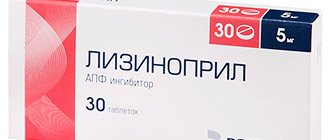Instructions for use of Lisinopril
In the process of developing hypertension, stimulation of the renin-angiotensin-aldosterone system (RAAS), which is responsible for the concentration of water, electrolytes and vascular tone, plays an important role.
Various structural mechanisms are involved in the regulation of vascular tone:
- various parts of the central nervous system (CNS);
- peripheral fibers of the autonomic nervous system;
- humoral factors (RAAS, sympathoadrenal, kalikrein-kinin system);
- prostaglandins are powerful vasoconstrictors (cause vasoconstriction);
- prostacyclins - dilate arterioles.
The RAAS is presented as a complex combination of enzymes and hormones, the main components of which are:
- angiotensinogen;
- renin;
- angiotensins I and II;
- receptors on the vascular wall that are sensitive to angiotensin II.
There are two main theories in the development of hypertension:
- Dysfunction of nervous regulation. Occurs against the background of insufficiency of hormonal mechanisms influencing the tone of arterioles, previous kidney diseases, age-related changes in blood vessels, endocrine disorders during menopause.
- Imbalance between pressor and depressor influences. An increase in the tone of the vascular wall occurs against the background of depletion of the depressor effects of the kidneys.
As a result of the above violations, the following occurs:
- volume overload of the vascular bed;
- increased cardiac output (CO);
- hyperstimulation of the sympathetic nervous system (SNS);
- renal dysfunction;
- increase in total peripheral vascular resistance (TPVR).
Volume overload of the vascular bed develops due to the accumulation of Na ions in the plasma and the vessel wall, which entails its swelling, the lumen narrows and the peripheral vascular resistance increases. Na ions increase the sensitivity of the smooth muscle layer of the vessel to angiotensin II and norepinephrine. Through narrowed arterioles, blood enters the organs in smaller quantities (relative hypovolemia). In response to this, the heart is forced to contract stronger and more often (as a result of activation of the SNS). Norepinephrine also causes spasm of the smooth muscles of arterioles, which provokes an even greater increase in blood pressure.
Prolonged spasm of arterioles in the kidneys causes a drop in pressure in the capillaries supplying the juxtaglomerular apparatus (JGA). In order to compensate for hypoxia, JGA releases renin into the bloodstream, which, under the action of angiotensin-converting enzyme (ACE), forms a substance that persistently constricts blood vessels - angiotensin II.
Mechanism of action of angiotensin II:
- interacts with special receptors on the myocytes of the blood vessels of the kidneys, lungs, liver, aorta, spleen, brain, adrenal glands;
- stimulates the vascular-motor center in the posterior part of the brain;
- increases the secretion of norepinephrine;
- influence on the functioning of the medullary layer of the adrenal glands (even more adrenaline enters the bloodstream) and cortical layer (secretion of aldosterone, which increases the retention of Na and water by the kidneys;
- independently activates the absorption pathways of Na and water in the tubules, bypassing the participation of aldosterone.
What kind of drug is this and what does it help with?
Lisinopril is an antihypertensive drug with a long-term effect, belonging to the group of angiotensin-converting enzyme inhibitors (ACE inhibitors). The drug is a representative of class III (a hydrophobic metabolite of Enalapril).
Pharmacological classification of ACE inhibitors
| Class | A drug | Bioavailability on an empty stomach/with food | Route of elimination | Plasma protein binding | Frequency of administration (per day) |
| Class I (lipophilic) | Captopril | 75%/35% | Liver – 10% Kidneys – 90% | 25-30% | 3 |
| Class IIa (lipophilic with predominantly renal elimination) | Quinapril | 38%/38% | Liver – 50% Kidneys – 50% | 97% | 2 |
| Perindopril | 65%/65% | Liver – 10% Kidneys – 90% | 20% | 2 | |
| Enalapril | 60%/60% | Liver – 10% Kidneys – 90% | 50% | 2 | |
| Class IIb (lipophilic with two elimination pathways) | Ramipril | 60%/60% | Liver – 40% Kidneys – 60% | 75% | 1 |
| Fosinopril | 36%/36% | Liver – 50% Kidneys – 50% | 95% | 1-2 | |
| Class III (hydrophilic) | Lisinopril | 25%/25% | Kidneys – 100% | 5% | 1 |
The principle of action is to block the activity of one of the key enzymes of the RAAS, which promotes the conversion of the inert form of angiotensin-I into the highly active angiotensin-II.
Actions of Lisinopril:
- stimulation of renin production and reduction of angiotensin;
- bradykinin breakdown;
- blocking aldosterone production;
- vasodilation (expansion) of arterioles and veins;
- correction of pre- and afterload on the myocardium;
- reduction of Na retention by the kidneys;
- prevents worsening dilatation of the left ventricular (LV) cavities;
- regression of LV hypertrophy phenomena;
- decreased proliferation (growth) of smooth muscle cells in the walls of blood vessels;
- stabilization of heart rhythm (improved myocardial trophism, increased concentration of K+ and Mg+ ions in plasma);
- nephroprotection by improving blood flow in the kidneys;
- capable of reducing platelet aggregation (stimulates the secretion of prostaglandin E2, prostacyclin, endothelium-relaxing factor);
- Slowing the progression of atherosclerosis;
- Antioxidant effect;
- Optimizing glucose metabolism.
Lisinopril is the only representative of the ACE inhibitor that does not undergo metabolic transformations in tissues and is completely eliminated by the kidneys without changing its structure. The drug can be safely used in patients with decreased liver function (as it is a ready-made active drug).
Lisinopril is hydrophilic; this means that for its transportation throughout the body there is practically no need to form compounds with albumin in the blood. This allows the drug to be prescribed to patients with hypoalbuminemia and combined with medications that require transport proteins (cardiac glycosides, anticoagulants, antiarrhythmics).
This medicine increases the compliance of elastic-type vascular walls (including the aorta). Lisinopril also blocks the release of protein molecules into the urine in patients with diabetes, that is, it slows down the progress of latent nephropathy.
Lisinopril has the ability to sensitize tissues to insulin, which gives it an advantage in the treatment of patients with a combination of hypertension and type II diabetes mellitus.
Due to its hydrophilic qualities, the drug practically does not dissolve and is not deposited in adipose tissue, therefore it is more preferable for use in overweight patients.
The bioavailability of Lisinopril ranges from 26-50%; food does not interfere with the absorption of the drug. The maximum concentration of the drug is detected in the blood after 6-7 hours. The half-life is 12 hours. The decrease in blood pressure begins 60 minutes after taking the tablet. The effect of treatment stabilizes after 1 month of systematic use.
This makes it possible to take a Lisinopril tablet once throughout the day and maintain a stable blood pressure level, as well as avoid morning rises in blood pressure.
Indications: why is the medicine prescribed?
Lisinopril may be the only drug in the diet or a component of complex therapy for cardiovascular pathologies.
According to studies, the use of Lisinopril stabilizes blood pressure levels in 50-80% of patients with hypertension of I and II severity.
Indications for use:
- primary and secondary forms of arterial hypertension (especially with a long history);
- chronic circulatory failure with LV systolic dysfunction;
- acute coronary syndrome (with systolic pressure above 100 mmHg);
- prevention of recurrent cardiovascular accidents in patients after AMI;
- insulin-dependent form of diabetes mellitus type II, complicated by nephropathy.
How to take and in what dosages?
It is enough to take Lisinopril once a day, optimally in the first half of the day, without being tied to meals. The best clinical effect is achieved with systematic use of the drug at the same time.
Arterial hypertension.
The initial dosage is 2.5 mg/day. To achieve a stable effect, you need to take the drug for 2-4 weeks. And only after this, if necessary, increase the dose to 10-20 mg/day within 1 week.
The usual maintenance dose is 10-20 mg (maximum daily dose is 40 mg).
It is not recommended to exceed the dosage of 40 mg; it is better to additionally prescribe an antihypertensive drug of another group.
Heart failure.
The saturation dose is 2.5 mg/day. Gradually it is brought to the average therapeutic dose of 20 mg/day.
Acute coronary syndrome.
Patients with AMI and ST segment elevation are recommended to use Lisinopril on the first day after the onset of an anginal attack.
The initial dosage is 5 mg/day, the average therapeutic dosage is 10 mg/day. In case of arterial hypotension, when SAT <100 mmHg, the dose of the drug is reduced to 2.5 mg/day.
The duration of the course is 6-7 weeks, then additional studies are required to confirm the presence of indications for further use of the drug (if LV dysfunction is detected, it is recommended to continue treatment at a dosage of 10-20 mg/day).
Nephropathy in patients with diabetes mellitus.
The starting dose of Lisinopril is 10 mg/day (maximum 20 mg/day).
In case of clinically significant renal dysfunction, the dose of Lisinopril should be calculated taking into account creatinine levels. Maximum - no more than 20 mg/day.
In some clinical cases it is worth increasing the intervals between doses to 48 hours.
To better stabilize blood pressure, it is advisable to combine Lisinopril with diuretics (Hydrochlorothiazide, Indopamide).
Contraindications for use and symptoms of overdose
Contraindications to the use of Lisinopril:
- Absolute: Pregnancy and breastfeeding.
- Bilateral narrowing of the renal arteries.
- Quincke's edema.
- Primary hyperaldosteronism.
- Intolerance or allergy to any of the components of the drug.
- Severe stenosis of the aortic and mitral valves.
- Obstructive form of hypertrophic cardiomyopathy (HCM).
- Anuria.
- Arterial hypotension (SAT below 70 mmHg).
- Cardiogenic shock.
- Diffuse connective tissue pathology (dermatomyositis, systemic lupus erythematosus, nodular and rheumatoid polyarthritis, scleroderma).
If you suspect poisoning with Lisinopril, you must immediately stop treatment, induce vomiting, take a sorbent, lay the patient horizontally with the head and legs raised, and urgently call an ambulance.
Side effects
In general, Lisinopril is well tolerated by patients - the reactions that occur are mild and do not require discontinuation of use of the drug.
Possible adverse reactions:
- Arterial hypotension (often the “first dose effect”), dizziness with a sudden change in body position, palpitations, general malaise, blurred vision; In patients with AMI, II-III degree AV block and cardiogenic shock may develop within 24 hours from the onset of the attack.
- Acute renal failure, dysuric manifestations, anuria, edema.
- Decreased sexual desire, gynecomastia.
- Dry obsessive cough, shortness of breath, decreased bronchial obstruction, “burnt tongue” syndrome.
- Indigestion, epigastric discomfort, nausea, loss of appetite, distortion of taste.
- Skin rashes, redness, itching, angioedema (possibly fatal), urticaria, autoimmune reactions.
- Decrease in the number of red blood cells, platelets, leukocytosis.
- Sleep disturbance, anxiety, paresthesia, tinnitus, depression.
- Double vision, sensitivity to light, decreased visual acuity.
Lisinopril
Arterial hypotension
Most often, a pronounced decrease in blood pressure occurs with a decrease in blood volume caused by diuretic therapy, a decrease in the content of sodium chloride in food, dialysis, diarrhea or vomiting. In patients with CHF and with or without concurrent renal failure, a pronounced decrease in blood pressure is possible. When using the drug Lisinopril, some patients with CHF, but with normal or reduced blood pressure, may experience a marked decrease in blood pressure, which is usually not a reason to discontinue treatment.
In such patients, treatment with Lisinopril should be started under the strict supervision of a physician (with caution in selecting the dose of the drug and diuretics).
Before starting treatment with the drug, if possible, the sodium content should be normalized and/or the blood volume should be replenished, and the effect of the initial dose of Lisinopril on the patient should be carefully monitored.
Under strict medical supervision, Lisinopril should be used in patients with coronary heart disease, cerebrovascular insufficiency, in whom a sharp decrease in blood pressure can lead to myocardial infarction or stroke. Transient arterial hypotension is not a contraindication for further use of the drug. After blood pressure has been restored, it is possible to continue using the drug.
Renal dysfunction
In patients with impaired renal function (creatinine clearance less than 80 ml/min), the initial dose of lisinopril should be changed in accordance with the creatinine clearance (see section "Dosage and Administration"). Regular monitoring of potassium levels and creatinine concentrations in blood plasma is a mandatory treatment strategy for such patients. In patients with CHF, arterial hypotension can lead to deterioration of renal function. Cases of acute renal failure, usually reversible, have been reported in such patients. In case of acute myocardial infarction, drug therapy should not be started in patients with signs of renal impairment, i.e. with a plasma creatinine concentration of 177 µmol/l and/or proteinuria more than 500 mg/day. If renal function is impaired during the use of the drug (creatinine concentration exceeds 265 µmol/l or its value doubles before the start of therapy), it is necessary to consider discontinuing the drug.
Renal artery stenosis
In case of renal artery stenosis (especially with bilateral stenosis or in the presence of stenosis of the artery of a single kidney), as well as with peripheral circulatory failure due to a lack of sodium ions and/or fluid, the use of the drug Lisinopril can lead to impaired renal function, acute renal failure, which usually turns out to be irreversible even after discontinuation of the drug.
In acute myocardial infarction
The drug Lisinopril can be used simultaneously with standard therapy for acute myocardial infarction (thrombolytics, acetylsalicylic acid as an antiplatelet agent, beta-blockers).
The drug Lisinopril can be used simultaneously with a solution of nitroglycerin for intravenous administration or with nitroglycerin for administration using therapeutic transdermal systems, as well as nitroglycerin for sublingual use. The use of Lisinopril is not recommended in patients who have suffered acute myocardial infarction if systolic blood pressure does not exceed 100 mmHg. rt. Art. In case of persistent arterial hypotension (SBP less than 90 mm Hg for more than 1 hour), the drug must be discontinued.
Surgery/general anesthesia
During extensive surgical interventions, as well as when using other drugs that cause a decrease in blood pressure, lisinopril, by blocking the formation of angiotensin II, can cause a pronounced, unpredictable decrease in blood pressure. Before surgery (including dentistry), the surgeon/anesthesiologist should be informed about the use of an ACE inhibitor.
In elderly patients, the use of standard doses leads to higher concentrations of lisinopril in the blood, so special care is required when determining the dose.
Mitral stenosis/aortic stenosis/hypertrophic obstructive cardiomyopathy
Lisinopril, like other ACE inhibitors, should be administered with caution to patients with left ventricular outflow tract obstruction (aortic stenosis, hypertrophic obstructive cardiomyopathy), as well as to patients with mitral stenosis.
Anaphylactoid reactions during desensitization
There are isolated reports of the development of anaphylactoid reactions in patients receiving ACE inhibitors during desensitizing therapy, for example, with hymenoptera venom. ACE inhibitors should be used with caution in patients susceptible to allergic reactions undergoing desensitization procedures. The use of ACE inhibitors should be avoided in patients receiving bee venom immunotherapy. However, this reaction can be avoided by temporarily discontinuing the ACE inhibitor before starting the desensitization procedure.
Hypersensitivity/angioedema
Angioedema of the face, extremities, lips, tongue, epiglottis and/or larynx, which may occur during any period of treatment, has rarely been reported in patients taking an ACE inhibitor, including lisinopril. In this case, treatment with the drug should be stopped as soon as possible, and the patient should be monitored until symptoms completely regress. Angioedema with laryngeal edema can be fatal. Swelling of the tongue, epiglottis or larynx can cause airway obstruction, so appropriate therapy (0.3-0.5 ml of 1:1000 epinephrine (adrenaline) solution subcutaneously) and/or measures to ensure airway patency should be immediately carried out. In cases where the swelling is localized only on the face and lips, the condition most often goes away without treatment, but the use of antihistamines is possible.
The risk of developing angioedema is increased in patients who have a history of angioedema not associated with previous treatment with ACE inhibitors.
In rare cases, intestinal angioedema develops during therapy with ACE inhibitors. In this case, patients experience abdominal pain as an isolated symptom or in combination with nausea and vomiting, in some cases without previous angioedema of the face and with normal levels of Cl-esterase. The diagnosis is made using computed tomography of the abdominal cavity, ultrasound, or at the time of surgery. Symptoms disappear after stopping ACE inhibitors. In patients with abdominal pain taking ACE inhibitors, the possibility of developing angioedema of the intestine must be taken into account when making a differential diagnosis.
Concomitant use with mTOR (mammalian Target of Rapamycin) inhibitors, for example, temsirolimus, sirolimus, everolimus, racecadotril (an enkephalinase inhibitor used to treat acute diarrhea), estramustine
In patients concomitantly receiving therapy with mTOR inhibitors, racecadotril, estramustine, the risk of developing angioedema (for example, swelling of the airways or tongue with or without impairment of respiratory function) may be increased (see section "Interaction with other drugs").
Anaphylactic reactions during low-density lipoprotein (LDL) apheresis
In rare cases, life-threatening anaphylactoid reactions may occur in patients receiving ACE inhibitors during LDL apheresis using dextran sulfan. To prevent an anaphylactoid reaction, ACE inhibitor therapy should be temporarily discontinued before each apheresis procedure.
Hemodialysis
Anaphylactoid reactions have also been observed in patients on hemodialysis using high-flow dialysis membranes (eg, AN69®) who are also taking ACE inhibitors. In such cases, the use of a different type of dialysis membrane or another antihypertensive agent should be considered.
Neutropenia/agranulocytosis/thrombocytopenia/anemia
During therapy with ACE inhibitors, neutropenia/agranulocytosis, thrombocytopenia and anemia may develop. With normal renal function and the absence of other complications, neutropenia rarely occurs. ACE inhibitors are used only in emergency cases in the presence of systemic vasculitis, immunosuppressive therapy, taking allopurinol or procainamide, as well as when combining all of these factors, especially against the background of previous renal failure. There is a risk of developing severe infectious diseases that are resistant to intensive antibiotic therapy. When carrying out therapy with Lisinopril in patients with the above factors, it is necessary to regularly monitor the number of leukocytes.
Lithium preparations
The combined use of Lisinopril and lithium preparations is not recommended (see section “Interaction with other drugs”).
Dry cough
Cough has been reported when using ACE inhibitors. The cough is dry and prolonged, which disappears after stopping treatment with an ACE inhibitor. In the differential diagnosis of cough, cough caused by the use of an ACE inhibitor must also be taken into account.
Ethnic differences
It should be taken into account that patients of the Negroid race have a higher risk of developing angioedema. Like other ACE inhibitors, lisinopril is less effective in lowering blood pressure in black patients. This effect may be associated with a pronounced predominance of low-renin status in black patients with arterial hypertension.
Double blockade of the RAAS
Cases of hypotension, syncope, stroke, hyperkalemia and renal dysfunction (including acute renal failure) have been reported in susceptible patients, especially when used concomitantly with drugs that affect this system. Therefore, double blockade of the RAAS by combining an ACE inhibitor with an ARA II or aliskiren is not recommended. Combination with aliskiren and drugs containing aliskiren is contraindicated in patients with diabetes mellitus and/or moderate or severe renal impairment (GFR <60 ml/min/1.73 m2 body surface area) (see sections "Contraindications" and "Interaction" with other drugs") and is not recommended in other patients.
Concomitant use of lisinopril and ARB II in patients with diabetic nephropathy is contraindicated and is not recommended in other patients.
Potassium-sparing diuretics, potassium supplements, potassium-containing table salt substitutes and food supplements
Concomitant use with ACE inhibitors is not recommended (see section “Interaction with other drugs”).
Patients with diabetes mellitus
When using the drug in patients with diabetes mellitus receiving oral hypoglycemic agents or insulin, blood glucose concentrations should be regularly monitored during the first month of therapy.
Liver dysfunction
The use of ACE inhibitors can lead to the development of cholestatic jaundice with progression up to fulminant liver necrosis, so it is necessary to stop taking the drug if the activity of “liver” transaminases increases and symptoms of cholestasis appear.
Hyperkalemia
During therapy with ACE inhibitors, including lisinopril, hyperkalemia may develop. Risk factors for hyperkalemia include renal failure, old age, diabetes mellitus, certain concomitant conditions (for example, decreased blood volume, acute heart failure, metabolic acidosis), concomitant use of potassium-sparing diuretics (such as spironolactone, eplerenone, triamterene, amiloride), as well as potassium supplements or potassium-containing substitutes for table salt and the use of other drugs that increase the content of potassium in the blood plasma (for example, heparin). Hyperkalemia can cause serious heart rhythm problems, sometimes fatal. The simultaneous use of the above drugs should be carried out with caution.
Kidney transplant
There are no data on the use of lisinopril after kidney transplantation. Primary hyperaldosteronism
Patients with primary hyperaldosteronism are usually resistant to treatment with antihypertensive drugs that affect the RAAS. In this regard, Lisinopril is not recommended for use in such patients.
It is not recommended to drink alcohol (ethanol) during treatment with Lisinopril.
Lisinopril analogs
The original Lisinopril has an affordable price, but there are still many generics (analogs of the drug from different manufacturing countries) on the market.
Substitutes (synonyms) for Lisinopril in Russia
- Lisinopril-Ratiopharm;
- Diroton (Hungary);
- Diropress (Germany, Slovenia);
- Iruzid (Croatia);
- Ko-Diroton (Poland, Hungary);
- Lysigamma (Germany);
- Rileys-Sanovel (Türkiye);
- Scopril (Macedonia);
- Equator (Hungary, Russia).
Lisinopril is available in the form of tablets of 5, 10 and 20 mg.
There are also many medications on the market that combine Lisinopril with other groups of antihypertensive substances:
- with Amlodipine (Equator, Tenliza);
- with Hydrochlorothiazide (Co-Diroton, Lisinopril-H,HL, Lizoretik);
- with Indopamide (Diroton-Plus).
Such combinations were created to simplify the regimen and reduce the number of tablets, which increases the likelihood of systematic use of the drug.
conclusions
Lisinopril is a long-acting ACE inhibitor that is highly effective. The drug is considered the “gold standard” in the treatment of hypertension and circulatory failure (together with diuretics, statins, angiotensin-II antagonists and Ca2+ channel blockers). The combined use of Lisinopril and Indapamide reduces the likelihood of recurrent episodes of ischemic stroke by 29% and intracranial hemorrhage by 50%.
It is worth remembering that the antihypertensive effect reaches a plateau no earlier than 10-14 days from the start of treatment.
Before using the drug, you must carefully read the instructions! Lisinopril should not be taken without a doctor’s prescription, and you should not replace it with an analogue yourself.
Instructions for use LISINOPRIL
Special caution is required when prescribing to patients with bilateral renal artery stenosis or stenosis of the artery of a single kidney (possible increase in the concentration of urea and creatinine in the blood), patients with ischemic heart disease or cerebrovascular disease, with decompensated chronic heart failure (possible arterial hypotension, myocardial infarction, stroke). ). In patients with chronic heart failure, the resulting arterial hypotension can lead to deterioration of renal function. A pronounced decrease in blood pressure during treatment most often occurs with a decrease in blood volume caused by diuretic therapy, restriction of salt intake, dialysis, diarrhea or vomiting. Treatment with lisinopril for acute myocardial infarction is carried out against the background of standard therapy (thrombolytics, ASA, beta-blockers). Compatible with intravenous administration of nitroglycerin or TTS of nitroglycerin. When using drugs that lower blood pressure in patients undergoing major surgery or during anesthesia, lisinopril may block the formation of angiotensin II, secondary to compensatory release of renin. Before surgery (including dental surgery), the surgeon/anesthetist should be informed about the use of an ACE inhibitor. Based on the results of epidemiological studies, it is assumed that the simultaneous use of ACE inhibitors and insulin, as well as oral hypoglycemic drugs, can lead to the development of hypoglycemia. The greatest risk of development is observed during the first weeks of combination therapy, as well as in patients with impaired renal function. In patients with diabetes mellitus, careful glycemic control is required, especially during the first month of ACE inhibitor therapy. Before starting treatment, it is necessary to compensate for the loss of fluid and salts. Risk factors for the development of hyperkalemia include chronic renal failure, diabetes mellitus, and concomitant use of potassium-sparing diuretics (spironolactone, triamperene, or amiloride), K+ preparations, or salt substitutes containing K+. Periodic monitoring of K+ concentration in blood plasma is recommended. In patients taking ACE inhibitors during desensitization to Hymenoptera, it is extremely rare that a life-threatening anaphylactoid reaction may occur. It is necessary to temporarily stop treatment with an ACE inhibitor before starting a course of desensitization. Anaphylactoid reactions may occur during simultaneous hemodialysis using high-flow membranes (including AN 69). The use of a different type of dialysis membrane or another antihypertensive drug should be considered. The safety and effectiveness of lisinopril in children has not been established. Use during pregnancy is contraindicated, except in cases where other drugs cannot be used or are ineffective (the patient should be informed of the potential risk to the fetus).










